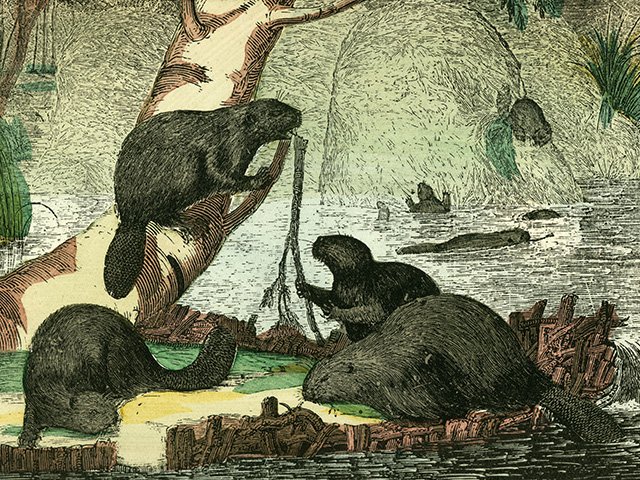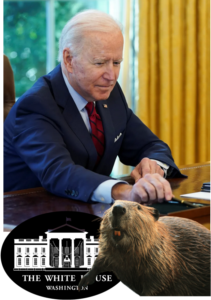As long as I’ve been writing about beavers, and probably long before that there have been two stares where fish and wildlife has been diligently blowing up beaver dams to “protect trout’. Explosives must be very fun because they have ignored all the data from Pollock and Wheaton that show how essential beaver habitat is to rearing salmonids and how the dams keep temperatures low. I figured that the single blessing of Emily Fairfax leaving California for Minnesota might be to push this argument to the forefront. Along with Bob Boucher’s fantastic Milwaukee research and subsequent legal action who has finally pushed it into the light.
Leave it to the beavers
 As Madison endures a long, hot summer of drought and wildfire haze, maybe it’s time to embrace what beavers have to offer.
As Madison endures a long, hot summer of drought and wildfire haze, maybe it’s time to embrace what beavers have to offer.
These industrious hydrologic engineers are champing at the sticks to restore the 50% of Wisconsin wetlands that were drained for farming, including much of Madison’s isthmus. Their ponds slow flooding during rainy seasons, store water for times of drought, create a swampy barrier against wildfires, and build habitat for other species ranging from woodpeckers to fish to amphibians.
Because of beavers’ documented ability to mitigate climate change, western states are encouraging beaver populations, and protecting them with new laws. In June, California declared beavers a “keystone species,” Seattle has installed pond levelers so beavers can build dams in its parks without flooding them, and groups such as the SLO Beaver Brigade document the health of local populations.
Europe, where beavers were wiped out during the craze for beaver skin hats, is restoring beavers into wetlands from Scotland to Russia. And with a documentary called The Beaver Believers, and the publication of two recent books extolling their virtues — Beaverland by Leila Philip and Eager by Ben Goldfarb — beavers are having their moment of fame.
Except, not so much in Wisconsin.
“We’re the only state that has a budget to destroy beavers; we’ve spent $15 million in the last 20 years to kill beavers,’’ says Bob Boucher, who claims the Wisconsin Department of Natural Resources is pursuing “a policy of beaver holocaust.” In the past decade, Boucher says U.S. Department of Agriculture Wildlife Services statistics indicate that federal and state policies have killed 28,141 Wisconsin beavers and blown up or destroyed 14,796 beaver dams through hand removal or explosives, accidentally killing 1,091 river otters in the process.
Good for you Bob. This is taking the fight right into the lion’s den. The department of natural resources in Wisconsin has been repeatedly shown the truth over the years, I know because I and other believers have personally have received letters back from them. They know better. It’s high time they do better.
 But Midwestern attitudes may be changing and there are moves afoot to rethink beaver management. Boucher’s group, Superior Bio-Conservancy, filed notice in late June that it intends to sue the wildlife services division of the USDA, which carries out the DNR’s orders to remove beavers along 1,800 miles of trout streams in Wisconsin. Boucher, who was co-author of a 2021 study that proposed using beavers to build $3.3 billion worth of flood-proofing along the Milwaukee River watershed, says he’s made 17 requests to meet with the DNR on its beaver policy, only to be rebuffed.
But Midwestern attitudes may be changing and there are moves afoot to rethink beaver management. Boucher’s group, Superior Bio-Conservancy, filed notice in late June that it intends to sue the wildlife services division of the USDA, which carries out the DNR’s orders to remove beavers along 1,800 miles of trout streams in Wisconsin. Boucher, who was co-author of a 2021 study that proposed using beavers to build $3.3 billion worth of flood-proofing along the Milwaukee River watershed, says he’s made 17 requests to meet with the DNR on its beaver policy, only to be rebuffed.
“I hope that a stern talking-to from a judge may get them to pay attention,’’ he says.
And beavers in northern Wisconsin trout streams will be the topic of the annual trout stream improvement workshop Aug. 15, co-sponsored by the DNR and UW-Stevens Point. Another Midwest beaver and trout management conference, sponsored by the American Fisheries Society, is set for a week later in Grand Rapids, Michigan.
Dynamiting beaver dams to “improve” streams for trout has long been a DNR policy.
Sometime, when you’ve ignored information for so long it’s become automatic, and everything still isn’t working even though you have poured buckets of money into your projects, sometimes when that happens and you’re at a loss to know what to do next, it’s time to try something NEW. Maybe even listening.
Trout biologist Ray White, who will be a speaker at the August event in Hayward, grew up in Madison and remembers watching a nature movie at the Wisconsin Historical Society in the 1940s that showed game wardens ridding Wisconsin of beavers to encourage trout.
“I knew even as a kid that Wisconsin wanted to remove beavers,’’ says White, who worked at the Wisconsin DNR before going on to faculty positions at Michigan State and Montana State. “And then I became a biologist and I became involved in it. We felt beavers were messing up our work.”
Today, White, 88, sees the issue as less clear cut. Eastern brook trout, Wisconsin’s native species, and beavers evolved together in Wisconsin. While trout improvement dogma declares that beaver dams cause trout streams to warm up and silt up behind the dams, White says that isn’t necessarily a problem for trout spawning.
“It turns out that eastern brook trout spawn where groundwater comes up through the gravel, they seek out places where they can feel the upwelling water,’’ he says. “If the silt is thin enough at the edge of a beaver pond, they can still spawn there.”
Whoa. He’s very close. Is this story going to have a happy ending?
Still, White doesn’t oppose removing beavers from trout waters, saying, “we don’t need beavers everywhere.”
Nope. Maybe not that close.
Another workshop speaker Emily Fairfax, a hydrologist at the University of Minnesota, says that her research shows that beaver dams can have a beneficial effect, forcing moving water downwards, where it mingles with chilly groundwater and remerges much colder.
“I’ve felt this, walking down beaver-dammed streams, and suddenly you’ll feel this ice cold stream of water coming up,’’ Fairfax says. “So beaver ponds will have super cool pools that trout love, warmer pools that turtles and amphibians love, there’s something for everyone in this habitat. Beavers are really, really good at creating these biodiversity hotspots.”
Fairfax, who did her beaver research in California and other western states, says Wisconsin lacks solid data on its beaver populations because the DNR does not track the number of beavers killed by private landowners. (In his complaint, Boucher notes the USDA wildlife services kills three times more beavers per year than planned in its 2013 environmental assessment plan.)
Go Emily. Go Bob. Go Beavers.
“We have what I call ‘ecological amnesia,’ because it’s been 200 or 300 years since beavers were really abundant,’’ Fairfax says. The first Europeans who arrived in Wisconsin were fur traders, and they encountered a wet, paleo landscape of braided streams that would flood during wet seasons and contract during dry times.
Based on her California experience, Fairfax says it may take a lawsuit to get Wisconsin’s beaver believers working with the trout fanciers. It also may take a climate-fueled disaster or two.
“The West was confronted with climate disasters much sooner, and those are situations where you really see the benefits of beavers,’’ Fairfax says. “If we want to be climate resilient, we need more wetlands, and beavers are great builders of wetland
Just remember, first they ignore you. Then they laugh at you. Then they fight with you. Then you win.
I would say the badger state has officially moved into stage 3. Stay Tuned.








